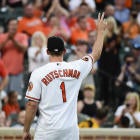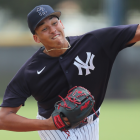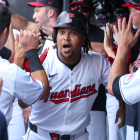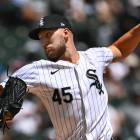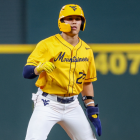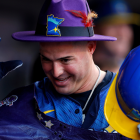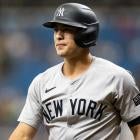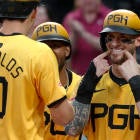With the regular season concluding, we've decided to take a look at each team's future -- not by using a crystal ball or other psychic abilities, but by evaluating their farm systems. Below you'll find our ranking of the top five prospects in the organization -- sorted by perceived future potential -- as well as five other players who fit various categories. Those categories are:
2020 contributor: A player who is likely to play a role for the big-league team next season.
Analyst's pick: A player who is a strong statistical performer and/or whose underlying measures are better than the scouting reports suggest.
Riser: A player on the way up.
Faller: A player on the way down.
One to watch: An interesting player to keep in mind (for whatever reason).
These rankings were compiled after talking with various industry sources about the systems (and players) in question. It should be acknowledged that this process is more art than science, and that there are limits to ordinal rankings. Still, it's an intuitive system, and our hope is that the write-ups will answer any questions by providing additional context and analysis of each player -- such as their pluses and minuses; the risk factors involved; and their estimated arrival date.
One last word on eligibility: we're following MLB's rookie guidelines by disqualifying any player with more than 130 big-league at-bats or 50 innings pitched.
The Orioles had the No. 1 pick in June for the first time since 1989 and made good use of it, selecting a potential franchise cornerstone. This is an organization that's early into an all-out rebuild, but there's some legitimate talent at the top of the system -- and more intrigue elsewhere than might be expected given the poor big-league roster.
1. Adley Rutschman, C
The shiny new toy syndrome often manifests in these lists in the form of recent draftees ranking higher than they should. It makes some baseball sense -- after all, most of them haven't had enough time to fail as professionals, leaving us with nothing to weigh but their potential and upside. Adley Rutschman, the top pick in June's draft, is the only choice for the top spot here.
Rutschman, who gets to repurpose his orange-and-black gear from his days at Oregon State, doubles as the best catching prospect in the minors. Scouts believe he'll wind up with four plus or better tools -- or, everything but the run tool. (Hey, he's a catcher.) Additionally, he has a mature approach at the dish and other teams' internal metrics grade him as a good framer. Factor in Rutschman's perceived intangibles, and there's a decent chance he's both a middle-of-the-order hitter and a field general-style defender. That would make him a perennial All-Star candidate and one of the better players in baseball in any given season.
The biggest knock on Rutschman may be none of his own doing, but rather Matt Wieters's failure to live up to his once-lofty promise. It's worth remembering that Wieters (though seldom the transformative player some forecasted him as) has authored an 11-season career in which he's made four All-Star teams and has accumulated enough Wins Above Replacement to rank as the ninth-most productive No. 5 pick in history. If that Rutschman's floor, then it's a nice floor.
2. Grayson Rodriguez, RHP
Dan Duquette's final first-round selection in Baltimore, Grayson Rodriguez, is shaping up to be a quality parting gift.
Rodriguez, who won't turn 20 until mid-November, spent the season in the South Atlantic League, striking out 129 batters and yielding just four home runs in 94 frames. He already looks like a big-league starter (he's listed at 6-foot-5 and 220 pounds), and his arsenal could offer both impact and depth upon maturation. His fastball can touch into the upper-90s and he has a knockout slider that serves as his main out pitch. Rodriguez will continue to work on shaping the rest of his repertoire, including a slow changeup that clocks in 13 to 14 mph below than his heater, per Trackman data. (The largest gap in the majors this season is 12.8 mph and belongs to Matt Boyd, per data from FanGraphs -- and Boyd seldom uses his changeup.)
Every young starter could "wind up in the bullpen," much in the way that every protagonist in a Haruki Murakami novel could end up in an alternate dimension -- it happens often enough that the caveat should be implicit. All the same, Rodriguez checks enough boxes to think he has a better chance than not of spending his years in a rotation -- or, uh, another realm.
3. DL Hall, LHP
Should the need ever arise to define DL Hall with one statistic, the pick from this season's litter would be that he permitted more walks (54) than hits (53).
Hall is an abstract pitcher who transcends such reduction. He has two, sometimes three above-average pitches that give him a mid-rotation ceiling or better and grant him excellent contact-suppression skills -- evidenced by him allowing 131 hits and 10 home runs in 185 professional innings. He's plenty athletic, too, and there's a chance he'll become more aligned with his release point as time beats on. If that comes to pass, he may make an All-Star Game.
The more interesting outcome -- from a certain perspective, anyway -- is if Hall remains inconsistent and his trajectory winds up interlacing with the league-wide erosion (or evolution) of conventional pitching roles. Would he end up scratching out 25-plus shorter starts each season? Or would he be slotted into a multi-inning relief role (where he would likely perform well)? Maybe he's Gio Gonzalez, maybe he's Sean Newcomb; maybe he's neither, and maybe he's something that doesn't quite exist yet.
So much of player evaluation is based on running players through mental models and frames of reference. Sometimes a pitcher like Hall comes around at a time when the game is changing, forming a combination of player and movement that short-circuits everything. There's no telling what the future holds for Hall as of right now, but finding out should be fun.
4. Yusniel Diaz, OF
Yusniel Diaz is a fine outfield prospect who should reach the majors before next year's end. Nonetheless, he's at risk of disappointing anyone who looks at his signing bonus ($15.5 million) and inclusion as the centerpiece of the Manny Machado trade and deems him a budding star.
Diaz can hit and has shown a good feel for the strike zone. He pulled the ball more often this year, which in turn helped him post a career-high .210 ISO. It's worth monitoring if those gains carry over to Triple-A, since his bat will dictate his value for the most part. Diaz isn't a center fielder and he's not much of a baserunning threat -- he was caught stealing on all three of his attempts this season, giving him a career success rate of 42 percent -- leaving him as a corner outfielder light on secondary value.
Another aspect of Diaz's game worth monitoring: his health. He was limited to 85 games this season due to various leg injuries, meaning he's reached the 100-game mark once in four tries.
5. Adam Hall, INF
There is an accepted theory in scouting circles that cold-state players bloom later than their warm-state counterparts. If that thinking proves correct then Adam Hall, who played high school ball in Canada, could see his stock improve sooner than later.
Hall is a heady middle infielder with a lot going for him. He hits the ball hard (albeit often on the ground), and he improved both his strikeout and walk rates this season. He possesses good speed and uses it well, having succeeded on 80 percent of his 70 stolen-base attempts as a professional. Defensively, he seems more certain to stick at shortstop now than as a prepster.
This may look like an over-rank in 12 months (it probably looks like one now). But here's to gambling on Hall's well-rounded nature transcending his boring name and modest expectations.
2020 contributor: Ryan Mountcastle, 1B/LF
Ryan Mountcastle is 22 years old and coming off a season in which he batted .312 with 25 home runs in Triple-A. Why isn't he in the top five? (Heck, why isn't he in the majors?) Because his game features significant holes, beginning with his defense. Originally a shortstop-turned-third baseman, Mountcastle is now a first baseman/left fielder. The pressure isn't so much on his bat as it is conjoined to his bat like melted candy. That would seem like a good thing -- see his numbers this season -- except … Mountcastle is swing-happy and prone to zone expansion, resulting in a strikeout-to-walk ratio exceeding 5.40. All he's done is hit throughout his professional career, and there's a chance he continues to do so. There's also a chance he doesn't, and that he becomes just the second- or third-best of his kind on the Orioles' 25-player roster.
Analyst's pick: Zac Lowther, LHP
Zac Lowther is a physical southpaw who atones for average stuff by excelling at underlying aspects, some of which can now be quantified -- like a deep release point and a high spin rate. He's either going to end up the subject of 40 Eno Sarris articles, or he's going to throw fewer than 40 big-league innings. (It's possible he splits the uprights, but that isn't as attention-grabbing, now is it?) Lowther will open the season in Triple-A and could close it out in the majors.
Riser: Michael Baumann, RHP
In 11 starts at High-A, Michael Baumann posted a higher strikeout percentage than the aforementioned DL Hall. Baumann is down here instead of up there because he has a more limited upside. Though he's well-built and equipped with a steep release point and a good fastball, he's always lacked a standout secondary pitch. Baumann, to his credit, took a step in the right direction in 2019 by introducing a cutter that shows potential. He'll probably still end up in the bullpen, but his chances of avoiding that fate are healthier now than they were a year ago.
Faller: Austin Hays, OF
Austin Hays, who first debuted in the majors back in 2017, finally played in his first Triple-A contest this season after missing significant time due to a heel injury. He was a below-average hitter in 59 games relative to his peers, and while he's only 24 it's looking unlikely that he'll develop into a big-league regular. Hays remains a swing-happy, pull-heavy hitter who'll need to hit for a decent average and good pop to get by at the plate. If he can't do it in Triple-A, why would anyone think he can in the majors?
One to watch: Cadyn Grenier, INF
The Orioles selected Cadyn Grenier out of Oregon State in 2018 based on his well-above-average speed and his ability to stick at shortstop. A year-plus later, the most pressing question facing him is whether he'll hit enough to reach the majors. Grenier struck out in more than 30 percent of his plate appearances in the low minors, a stat he owes to a passive approach and the swing-and-miss in his game -- a surprising amount given his lack of power. His secondary skills give him a wide berth, and if he can figure things out at the dish he has a chance to become a starting-caliber infielder.









